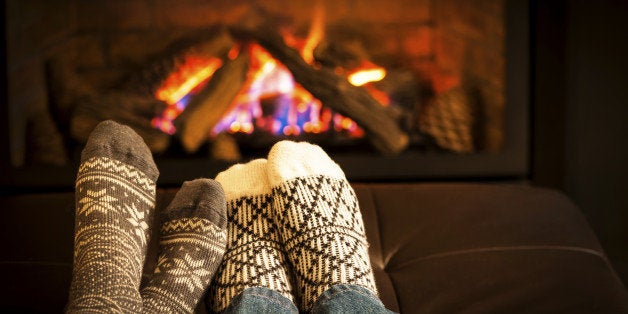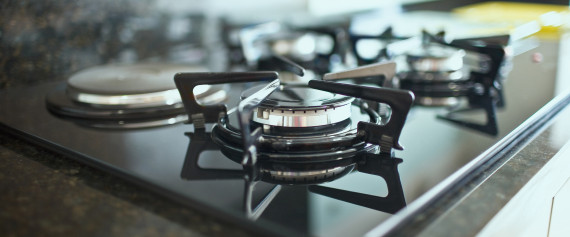
It's that time of the year when the temperatures start to drop and you find yourself turning on your stove and cranking up the heat. With all the fireplaces, heaters and stoves on full blast, it's especially important to be up-to-date on how to safely keep your home protected when it comes to fires.
We spoke with G. Keith Bryant, the President and Chairman of the Board of the International Association of Fire Chiefs (IAFC) and Tom Olshanki, a spokesperson for the US Fire Administration about all the tools and devices you should have to protect yourself and the things you absolutely need to know in order to keep you (and your loved ones) safe this season.
Here are the three things you need:
1. SMOKE DETECTORS
Why You Need One
According to the U.S. Environmental Protection Agency (EPA), it's important to have a smoke alarm because they will quickly detect smoke particles from "fast flaming fires that give off little smoke."
How Many Do You Need?
The amount of smoke alarms you should have depends on the size of your house. Bryant recommends a minimum of one alarm per level of your house. If your house is multi-leveled, he says you should have one at the top of the stairs, in every cooking area and in the living room. You should also make sure that there is an alarm outside every room someone sleeps in.
Where Should It Be Placed?
You want to place the alarm on a wall, a foot below the ceiling or on the ceiling itself. If you don't place it on the ceiling, you should make sure it's not more than 18 inches from the ceiling. "Smoke seeks a higher level first and it will give you that early detection that you need," says Bryant.
When Should It Be Replaced?
Bryant recommends a really easy guide on how often you should replace the battery on your smoke alarm: "Every time it's Daylight Savings Time, you should replace your battery to make sure it's fresh," he says. And you should test your alarm regularly. Be sure to read the instructions at the time of purchase. "They all come with a test button and if you read the directions, it's a simple matter of pushing that button until the alarm goes off," says Bryant. "If the alarm doesn't go off, then you need to change the battery." Some batteries may beep or chirp on their own when the battery needs to be replaced, but you may not be home to notice that, so you should always test it yourself.
2. CARBON MONOXIDE ALARMS

Why You Need One
According to the EPA, carbon monoxide is an odorless, colorless and deadly gas that can emit from space heaters, leaking chimneys, furnaces, gas water heaters, wood stoves, fireplaces and gas stoves. Since it's impossible to detect this gas on your own, it's vital to have at least one carbon monoxide detector in your home.
How Many Do You Need?
This really depends on the kind of home you have, but Bryant says you should "definitely have one near an area of heating (a room with a fireplace or stove) and hot water heaters."
Where Should It Be Placed?
Bryant says the general rule should be to just place the detector on the wall or on the ceiling near the appliance that could be emitting carbon monoxide. So if you have a room with a gas water heater, for instance, place the detector close to the heater. It's also a good idea to place some in the hallways near rooms where people are sleeping.
When Should It Be Replaced?
If the detectors are battery powered, the same rules that were given on smoke detectors apply on how and when to test carbon monoxide detectors. Use the "When it's Daylight Saving Time, change your battery" rule for these. Bryant also says to test your carbon monoxide detector every single month.
Some devices do double duty: Search your local hardware store for a "Combination Carbon Monoxide/Smoke Alarm."Olshanski says to make sure that the device has a label that indicates it's been tested by the UL (Underwriters Laboratories Inc) or the "FM" (Factory Mutual), or that it has proven itself under test facilities. "Those companies give the certification that the devices act as they should as far as detecting the proper amount of concentration of smoke or carbon monoxide," says Bryant. "You want to make sure that those alarms work within the recommended limits."
3. FIRE EXTINGUISHERS
Why You Need One
These are really good for putting out small fires, but you also need to strongly be aware of when is the right time to use one. Sometimes fires can get to a certain degree where it is actually more dangerous to use an extinguisher, since you are delaying notification to the fire department. For the most part, fire extinguishers are meant for small, localized fires -- like in a trash can or on a stovetop. "But if you have a room that has a fairly involved fire, meaning if the furniture has ignited and the fire is quickly spreading, you would want to get out immediately and not try to do it yourself," says Bryant.
How Many Do You Need?
You'll want an extinguisher in every location in or around your house where a fire may occur. There are four types of extinguishers that are labeled as A, B, C and D. "A" extinguishers are for combustible material, like paper and wood, "B" extinguishers are for flammable liquids, "C" extinguishers are for electrical fires and "D" extinguishers are for metals. Olshanski says almost no one buys "D" extinguishers and most people usually purchase combination extinguishers of A/B or A/B/C.
Where Should It Be Placed?
You might want to have one in your garage for flammable liquids, and you might want to have one in the kitchen for local fires," says Bryant.
When Should It Be Replaced?
"Mostly, they need to be replaced right after they are used," says Bryant. But if you don't have a fire, Olshanski says that you should read the manufacturer's instructions on when to replace it. "Because of humidity or changing weather conditions in some areas, sometimes they'll cake," he says. "Just follow the instructions of the manufacturer."
OTHER IMPORTANT THINGS TO REMEMBER: